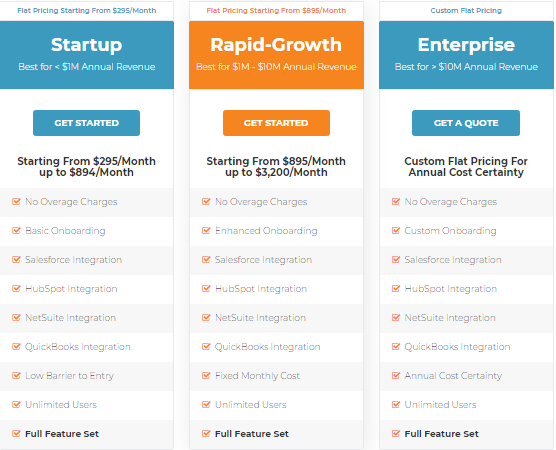The Fusebill pricing section is effective for several reasons:
1. Clear Hierarchy and Visual Appeal:
- Distinct Tiers: The “Startup,” “Rapid-Growth,” and “Enterprise” tiers are clearly labeled and visually separated with different background colors.
- Consistent Layout: Each tier follows a consistent layout with descriptions, pricing information, features, and call-to-action buttons.
- Visual Cues: Checkmarks are used to indicate included features, enhancing readability.
- Clear Headings: The headings clearly indicate the purpose and target audience of each tier, using revenue ranges for clarity.
- Pricing Clarity: The “Starting From” and “up to” monthly prices are prominently displayed.
- Call to Action Buttons: The “GET STARTED” and “GET A QUOTE” buttons are visually distinct and clearly labeled.
2. Value-Based Differentiation:
- Targeted Descriptions: Each tier has a concise description that clearly identifies the target customer and their needs based on revenue.
- Feature Progression: The feature lists clearly show the increasing capabilities of each tier, specifically with “Basic Onboarding,” “Enhanced Onboarding,” and “Custom Onboarding.”
- Specific Feature Differentiation: Features like “Fixed Monthly Cost” and “Annual Cost Certainty” differentiate the higher tiers.
- Quantitative Differentiation: The differences in price ranges provide clear quantitative differences.
3. Transparent Pricing:
- Clear Pricing Information: The “Starting From” and “up to” monthly prices are clearly stated for the “Startup” and “Rapid-Growth” tiers.
- Custom Pricing: The “Enterprise” tier uses “GET A QUOTE” and “Custom Flat Pricing For Annual Cost Certainty,” indicating a tailored solution for larger clients.
- No Overage Charges: The “No Overage Charges” feature is highlighted across all tiers, providing a sense of security.
4. Addressing Different User Needs:
- Small Businesses: The “Startup” tier caters to small businesses with lower revenue.
- Growing Businesses: The “Rapid-Growth” tier is designed for businesses experiencing rapid growth and higher revenue.
- Large Enterprises: The “Enterprise” tier caters to large enterprises with significant revenue and complex needs.
5. Strategic Use of Information:
- Benefit-Oriented Features: Features like “Salesforce Integration,” “HubSpot Integration,” and “QuickBooks Integration” highlight the value of each tier.
- Clear Call to Action: The call-to-action buttons provide clear paths for action.
- Feature Lists: The feature lists clearly show the differences between the tiers.
- Concise Descriptions: The descriptions are brief and to the point, making it easy to understand the purpose of each tier.
- Unlimited Users: The “Unlimited Users” feature is highlighted across all tiers, making it a key selling point.
- Full Feature Set: The inclusion of “Full Feature Set” in each tier indicates that there is no feature gating based on price tier.



